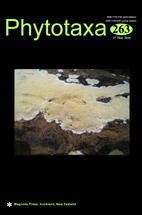Abstract
The Malagasy genus Carphalea (Rubiaceae) consists of six species (C. angulata, C. cloiselii, C. kirondron, C. linearifolia, C. madagascariensis, C. pervilleana) of shrubs or small trees and is recognizable by a distinctly lobed calyx, 2(–4)-locular ovaries, each locule with several ovules on a rod-like stalk arising from the base of the locule, and indehiscent fruits. Carphalea linearifolia, rediscovered in 2010, has not previously been included in any Rubiaceae molecular phylogenetic studies. We re-investigated the monophyly of Carphalea using sequence data from chloroplast (rps16 and trnT-F) and nuclear (ITS and ETS) markers analysed with parsimony and Bayesian methods. Carphalea linearifolia forms a clade with C. cloiselii and the type species C. madagascariensis. This clade is sister to a clade consisting of the rest of the Carphalea species plus the genus Triainolepis. According to these results, the new genus Paracarphalea is here described to accommodate Carphalea angulata, C. kirondron, and C. pervilleana. The conservation status of Carphalea linearifolia is assessed as critically endangered according to IUCN criteria.

